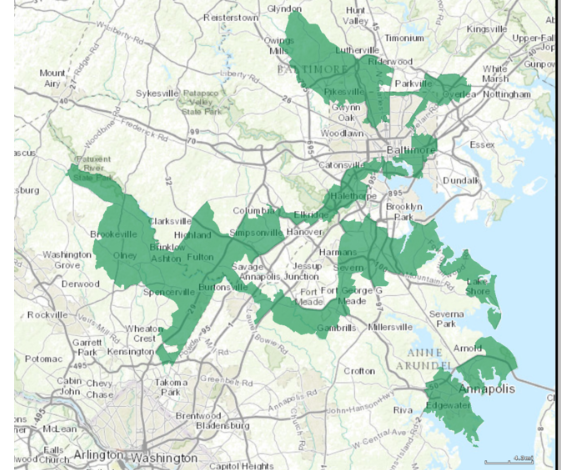
NPR – “A year and a pivotal justice’s retirement after the high court dodged the question, those seeking to break the political stranglehold over legislative redistricting are urging the justices to draw a line beyond which the Republican and Democratic parties cannot go in entrenching their political power, sometimes for decades at a time.”
Every ten years redistricting takes place after the decennial census.
Gerrymandering in the United States is the practice of setting boundaries of electoral districts to favor specific political interests within legislative bodies. Partisan gerrymandering to increase the power of a political party has been practiced since the beginning of the United States.
After racial minorities were granted the power to vote, some jurisdictions engaged in racial gerrymandering to weaken the political power of minority voters. In some instances, political parties have colluded to protect incumbents by engaging in bipartisan gerrymandering.
Maryland’s 3rd US Congressional District is considered to be among the most gerrymandered districts that exist today.

In June 2018, NPR reported, the SCOTUS was set to determine the con questions, with the exception then the states involved were Wisconsin and Maryland.
The Supreme Court in 1986 actually said that partisan gerrymandering is unconstitutional when the election system “is arranged in a manner that will consistently degrade a voter’s or a group of voters’ influence,” but as New York University election law professor Richard Pildes observed Monday, in the three decades since that decision, the high court has refused to enforce it with any teeth.
Last year’s cases two cases “illustrate the bare-knuckles practice both parties have used to maximize and perpetuate their own power through the re-drawing of legislative district lines.”
In one, Wisconsin Republicans controlled state legislature they “drew district lines so that even when the Democrats won a decisive statewide victory in terms of votes, the GOP carried nearly two-thirds of the legislative seats.”
In the second case, out of Maryland, it was Democrats who “drew congressional district lines to ensure that one of the two traditionally Republican congressional seats would flip to the Democrats.”
Instead of deciding the constitutional question, however, the court unanimously said that the plaintiffs in the lead case from Wisconsin had not shown that they had suffered the kind of injury that would allow them standing to seek intervention from the courts. In an unusual step, the justices, by a 7-to-2 vote, sent the case back to the lower courts, in order to give the Democratic voters a chance to present evidence of injury on a district-by-district basis, instead of a statewide basis. The Maryland case, likewise, was remanded to the lower courts.
Partisan gerrymandering is back at the U.S. Supreme Court.
A year and a pivotal justice’s retirement after the high court dodged the question, those seeking to break the political stranglehold over legislative redistricting are urging the justices to draw a line beyond which the Republican and Democratic parties cannot go in entrenching their political power, sometimes for decades at a time.
Two cases are before the court Tuesday. One is from Maryland, where Democrats drew new district lines to eliminate one of the state’s two GOP seats in the U.S. House of Representatives. The other is from North Carolina, where it was Republicans who drew maps to strengthen their political power.
But Kennedy retired last summer and was replaced by the far more conservative Justice Brett Kavanaugh. That leaves the odds heavily against those challenging partisan gerrymanders.
Uphill battle or not, on Tuesday it will be game on, with the focus mainly on North Carolina. There, the statewide vote is split roughly equally between Democratic and Republican voters, but the Republican-controlled state Legislature, in drawing the current congressional district lines, deliberately and openly drew them to maximize the GOP advantage.
As Republican David Lewis, chairman of the state House committee on redistricting, put it: “I propose we draw the maps to give an advantage to 10 Republicans and 3 Democrats, because I do not believe it’s possible to draw a map with 11 Republicans and 2 Democrats.”
